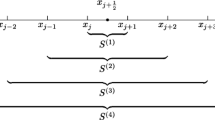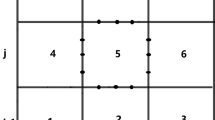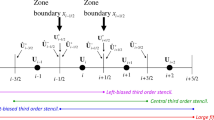Abstract
In this work, we extend the Fast and Optimized Weighted Essentially Non-Oscillatory (FOWENO) schemes for nonlinear degenerate parabolic equations. Fast WENO methods were introduced with the goal of reducing computational costs for the smoothness indicators calculations. Whereas, Optimal WENO schemes were developed to increase the accuracy of the approximation near critical points. Here, both techniques are adapted for degenerate parabolic conservative laws obtaining: FOWENO34 and FOWENO56 reconstructions, where the first and second digit represent the order of approximation for the convective and diffusive flux, respectively. By considering a SSP Runge-Kutta method for the time discretization, an experimental analysis is carried out in order to show the efficiency and accuracy of FOWENO approximations for one and two-dimensional parabolic problems with degenerate diffusion.













Similar content being viewed by others
References
Abedian, R., Adibi, H., Dehghan, M.: A high-order weighted essentially non-oscillatory (weno) finite difference scheme for non linear degenerate parabolic equations. Comput. Phys. Commun. 184, 1874–1888 (2013)
Acosta, C., Bürger, R.: Difference schemes stabilized by discrete mollification for degenerate parabolic equations in two space dimensions. IMA J. Numer. Anal. 32(4), 1509–1540 (2012)
Arandiga, F., Baeza, A., Belda, A.M., Mulet, P.: Analysis of weno schemes for full and global accuracy. SIAM J. Numer. Anal. 49, 983–915 (2011)
Arandiga, F., Martí, M.C., Mulet, P.: Weights design for maximal order weno schemes. J. Sci. Comput. 60, 641–659 (2014)
Arbogast, T., Huang, C., Zhao, X.: Finite volume weno schemes for non linear parabolic problems with degenerate diffusion on non uniform meshes. J. Comput. Phys. 399, 108921 (2014)
Aronson, D.: The porous medium equation, in Non-linear Diffusion Problems. 1224 (1986)
Baeza, A., Bürger, R., Mulet, P., Zorío, D.: On the efficient computation of smoothness indicators for a class of weno reconstructions. J. Sci. Comput. 80, 1240–1263 (2019)
Baeza, A., Bürger, R., Mulet, P., Zorío, D.: Weno reconstructions of unconditionally optimal high order. SIAM J. Anal. 57, 2760–2784 (2019)
Baeza, A., Bürger, R., Mulet, P., Zorío, D.: An efficient third weno scheme with unconditionally optimal accuracy. SIAM J. Sci. Comput. 42, A1028–A1051 (2020)
Balsara, D., Shu, C.: Monotonicity preserving weighted essentially non oscillatory schemes with increasingly high order of accuracy. J. Comput. Phys. 160, 405–452 (2000)
Bürger, R., Coronel, A., Sepúlveda, M.: On an upwind difference scheme for strongly degenerate parabolic equations modelling the settling of suspensions in centrifuges and non-cylindrical vessels. Appl. Numer. Math. 56, 1397–1417 (2006)
Carrillo, H., Páres, C., Zorío, D.: Lax-wendroff approximate taylor methods with fast and optimized weighted essentially non-oscillatory reconstructions. J. Sci. Comput. 86(15), 1573–7691 (2021)
Evje, S., Karlsen, K.: On the uniqueness and stability of entropy solutions of nonlinear degenerate parabolic equations with rough coefficients. Discrete Contin. Dyn. Syst. 9, 1081–1104 (2003)
Evje, S., Karslen, K.: Monotone difference approximations of bv solutions to degenerate convection-diffusion equations. SIAM J. Numer. Anal. 37(6), 1838–1860 (2000)
Flower, A.: The mathematics of model for climatology and environment. NATO ASI Ser. 48, 302–336 (1996)
Gottlieb, S., Shu, C., Tadmor, E.: Strong stability preserving high order time discretization methods. SIAM Rev. 43, 89–112 (2001)
Harten, A., Engquist, B., Osher, S., Chakravarthy, S.: Uniformly high order accurate essentially non-oscillatory schemes. J. Comput. Phys. 71, 231 (1987)
Henrick, A., Aslam, T.D., Powers, J.M.: Mapped weighted essentially non-oscillatory schemes: achieving optimal order near critical points. J. Comput. Phys. 207(2), 542–567 (2005)
Holden, H., Karlsen, K.H., Lie, K.A.: Operator splitting methods for degenerate convection-diffusion equations ii: Numerical examples with emphasis on reservoir simulation and sedimentation. Comput. Geosci. 4, 287–322 (2000)
Hu, C., Shu, C.W.: Weighted essentially non-oscillatory schemes on triangular meshes. J. Comput. Phys. 150, 97–127 (1999)
Jerez, S., Parés, C.: Entropy stable schemes for degenerate convection-diffusion equations. SIAM J. Numer. Anal. 55, 240–264 (2017)
Jiang, G., Shu, C.: Efficient implementation of weighted eno schemes. J. Comput. Phys. 126, 202–228 (1996)
Karlsen, K., Lie, K.: An unconditionally stable splitting for a class of nonlinear parabolic equations. IMA J. Numer. Anal. 19, 609–635 (1999)
Kurganov, A., Tadmor, E.: New high-resolution central schemes for nonlinear conservation laws and convection-diffusion equations. J. Comput. Phys. 160(1), 241–282 (2000)
Liu, X., Osher, S., Chan, T.: Weighted essentially non-oscillatory schemes. J. Comput. Phys. 115, 200–212 (1994)
Liu, Y., Shu, C., Zhang, M.: High order finite difference weno schemes for nonlinear degenerate parabolic equations. SIAM J. Sci. Comput. 33(2), 939–965 (2011)
Muskat, M.: The flow of homogeneous fluids through porous media, 1st edn. McGraw-Hill Book Co., New York (1937)
Proft J, R.B.: Discontinuous galerkin methods for convection-diffusion equations for varying and vanishing diffusivity. International Journal of Numerical Analysis & Modeling. 6(4) (2009)
Shi, J., Hu, C., Shu, C.W.: A technique of treating negative weights in weno schemes. J. Comput. Phys. 175, 108–127 (2002)
Shu, C.: Essentially non-oscillatory and weighted essentially non-oscillatory schemes for hyperbolic conservation laws. Adv. Numer. Approx. Nonlinear Hyperbolic Equ. 1697, 325–432 (1988)
Shu, C.W., Osher, S.: Efficient implementation of essentially non oscillatory schemes iii. J. Comput. Phys. 71, 231–303 (1987)
Yamaleev, N.K., Carpenter, M.: A systematic methodology for constructing high order energy stable weno schemes. J. Comput. Phys. 11, 4248–4272 (2009)
Zhang, Q., Wu, Z.: Numerical simulation for porous medium equation by local discontinuous galerkin finite element method. J. Sci. Comput. 38, 127–148 (2009)
Zhang, S., Shu, C.W.: A new smoothness indicator for the weno schemes and its effect on the convergence to steady state solutions. J. Sci. Comput. 31, 273–305 (2007)
Acknowledgements
This work was supported by CONACyT (México) (Project No. CB-2016 286437).
Author information
Authors and Affiliations
Corresponding author
Additional information
Publisher's Note
Springer Nature remains neutral with regard to jurisdictional claims in published maps and institutional affiliations.
WENO34 and WENO56 Reconstructions
WENO34 and WENO56 Reconstructions
Here, we develop WENO reconstructions for the fluxes \({\hat{f}}_{i+1/2}\), \({\hat{K}}_{i+1/2}\) and for the subfluxes \({\hat{f}}^{m_1}_{i+1/2}\), \({\hat{K}}^{m_2}_{i+1/2}\) defined in (8) associated to the stencils \(S_f\) and \(S_K\) proposed in (5) for \(r=1,2\).
Let us start for the case \(r=1\) where the stencils are
and the substencils are
for \(m_1=0,1\) and \(m_2=0,1,2.\) Using the values \(f(u_{i-1}),f(u_{i}),f(u_{i+1})\), we approximate \(f(u_{i+1/2})\) constructing a quadratic polynomial q(x). Obtaining
Analogously, we calculate polynomials \(q^0(x)\) and \(q^1(x)\) by considering values \(f(u_{i-1}),f(u_{i})\) and \(f(u_{i}),f(u_{i+1})\), respectively. Thus,
and
Notice that \({\hat{f}}_{i+1/2}=\frac{1}{3}{\hat{f}}^0_{i+1/2}+\frac{2}{3}{\hat{f}}^1_{i+1/2}\) which is according to Table 1. Now the WENO reconstruction for the convective flux is
where \(\omega _0^f\), \(\omega _1^f\) are defined in (9). For the diffusive flux, we get
In a similar way, using the points \(\{K_{i-1+m_2},K_{i+m_2}\}\) with \(m_2=0,1,2\), we get the polynomials \(p^0(x)\), \(p^1(x)\) and \(p^2(x)\) satisfying
It is easy to show that \(c_0^K=-1/12,c_1^K=7/6,c_2^K=-1/12\). Therefore,
Following the steps described in Section 2.1, we have \(\sigma ^+ =\frac{5}{2}\) and \(\sigma ^- =\frac{3}{2}\). So, the positive and negative weights are
and
Now we compute the nonlinear weights which are given by
where \(\omega ^+_{m_2}\) and \(\omega ^-_{m_2}\) are defined in (12). Finally, the reconstruction for the diffusive flux is
For the case \(r=2\), we have
Using the same procedure for the case \(r=1\), we get
Considering \( S^{m_1}_f=\{x_{i-2+m_1},x_{i-1+m_1},x_{i+m_1}\}\) for \(m_1=0,1,2\), we compute the fluxes
and the WENO reconstruction for the convective flux is obtained substituting into equation (7) for \({\hat{f}}_{i+1/2}\) and \(\omega _{m_1}^f\) defined in (9). For the diffusive flux, we consider the substencil
for \(m_2=0,1,2\) and we get
with
The corresponding linear weights satisfy
and to calculate the nonlinear weights, we have \(\sigma ^+ =\frac{42}{15}\) and \(\sigma ^- =\frac{27}{15}\). Thus, the positive and negative weights are
and
Finally the non-linear weights are obtained by
with \(\omega ^+_m\) and \(\omega ^-_m\) given in (12), and the WENO reconstruction is written of the form
Rights and permissions
About this article
Cite this article
Diaz-Adame, R., Jerez, S. & Carrillo, H. Fast and Optimal WENO Schemes for Degenerate Parabolic Conservation Laws. J Sci Comput 90, 22 (2022). https://doi.org/10.1007/s10915-021-01689-4
Received:
Revised:
Accepted:
Published:
DOI: https://doi.org/10.1007/s10915-021-01689-4
Keywords
- Weighted Essentially Non-Oscillatory (WENO) methods
- Parabolic conservation laws
- Degenerate diffusion
- Optimized weights




